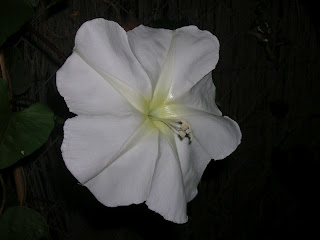IPOMOEA ALBA (sin. Calonyction aculeatum, Ipomoea bona-nox)
Origen: América tropical.
Es una trepadora de tallos no lignificados que, en zonas libres de heladas, es perenne y crece rápidamente hasta seis metros de altura o más.
Sus hojas tienen forma acorazonada. Produce grandes flores blancas y fragantes, que se abren al atardecer y duran una sola noche.
Sólo soporta heladas muy ligeras e incluso éstas dañan fuertemente a la planta.
English version:
Origin: Tropical America
Common names: Moon Flower Vine, Moon Vine.
It´s a soft-stemmed, evergreen perennial vine that, in frost free areas, grows fastly up to six metres or more.
Its leaves are heart shaped. Its flowers are white, big, fragant and open in late afternoon and last only until next morning.
It withstands only very light frosts and even them damage seriously the plants.


















































